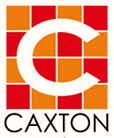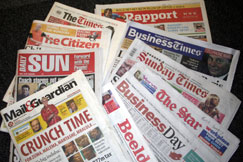Media
The press in South Africa
- South African Advertising Research Foundation: www.saarf.co.za
A free press
South Africa has always had a courageous and opinionated press. For more than 40 years the apartheid state tried to gag the country's newspapers, using legislation, harassment and imprisonment, culminating in the late-1980s States of Emergency. Through all of this, South Africa's newspapers defiantly reported the news. With democracy in 1994, South Africa's newspapers were freed from all restrictions. The country's Constitution, adopted in 1996, explicitly protects the freedom of the press in its Bill of Rights. Section 16 states: Everyone has the right to freedom of expression, which includes:- freedom of the press and other media;
- freedom to receive or impart information or ideas;
- freedom of artistic creativity; and
- academic freedom and freedom of scientific research
- propaganda for war;
- incitement of imminent violence; or
- advocacy of hatred that is based on race, ethnicity, gender or religion, and that constitutes incitement to cause harm.
- Press freedom in South Africa
- The Constitution of South Africa
- Consumer help: advertising and the media
- Reporters Without Borders: www.rsf.org
- South African Press Council: www.presscouncil.org.za
- South African Press Code: Full text
Trends in South African newspapers
The development of the South African press since the end of apartheid has been marked by two disparate trends: the stagnation and decline of the traditional mainstream newspapers; and the rise of tabloids with a black, working-class readership. The downturn experienced by South Africa's mainstream press mirrors the trend elsewhere in the world, where the internet has seriously disrupted the industry and free online news has eroded newspaper circulation. But South Africa's industry also experienced a growth spurt when, in 2002, the country's first tabloid was launched. Responding to a market created by steadily improving living conditions for many poorer South Africans, Media24 launched the Daily Sun. Aimed at the "blue collar worker", it filled an enormous gap in the market and it wasn't long before it broke through the 1-million reader mark. A decade on, it has more than 5.5-million readers, according to AMPS 2012. Daily Sun's success led to the "tabloidisation" of the industry, with other tabloids being launched, including the Afrikaans-language Son and the Daily Voice, which both target working class readers in the Western Cape. The newspaper landscape was further redefined by the success of vernacular- language newspapers, such as Isolezwe and Ilanga, which are both isiZulu newspapers. However, even these cleverly targeted newspapers have not been immune to pressures facing the industry, and 2012/13 circulation and readership figures remain under pressure. South African media companies are grappling with the substantial challenges of having to reinvent themselves with varying success.- Media analysis and commentary at www.grubstreet.co.za and Wits University's www.journalism.co.za
Ownership of South African newspapers
There are plenty of small, independent media houses, which publish magazines as well as in-house and business-to-business journals. The newspaper industry is dominated by four main players: Media24, Independent Newspapers, the Times Media Group, and CaxtonCTP. Media 24: Africa's leading publishing company, its operations
include newspapers, magazines, digital businesses, printing and distribution
companies. The company has a reputation for being adaptive and is especially agile in
its approach to digital products. Media24's majority shareholder is Naspers, one of
South Africa's most successful companies.
Media 24: Africa's leading publishing company, its operations
include newspapers, magazines, digital businesses, printing and distribution
companies. The company has a reputation for being adaptive and is especially agile in
its approach to digital products. Media24's majority shareholder is Naspers, one of
South Africa's most successful companies.
- Website: www.media24.com
 Independent Newspapers: Home to some of the country's oldest
titles, the group has 18 newspapers in its stable. Irish-owned Independent News &
Media sold its South African business to a consortium led by Sekunjalo Investments in
2013. In terms of the deal, the Government Employees Pension
Fund will aquire a
25% stake in the company.
Independent Newspapers: Home to some of the country's oldest
titles, the group has 18 newspapers in its stable. Irish-owned Independent News &
Media sold its South African business to a consortium led by Sekunjalo Investments in
2013. In terms of the deal, the Government Employees Pension
Fund will aquire a
25% stake in the company.
- Website: www.theinc.co.za
 Times Media Group: With a name change from Avusa to the Times
Media Group signalling cost-driven restructuring, the group has promised a focus on
digital platforms. Owners of BDFM, which publishes Business Day and
weekly business magazine the Financial Mail, as well as the
Sunday Times, South Africa's biggest newspaper. It has a magazine
division, and stakes in the Home Channel and Summit TV.
Times Media Group: With a name change from Avusa to the Times
Media Group signalling cost-driven restructuring, the group has promised a focus on
digital platforms. Owners of BDFM, which publishes Business Day and
weekly business magazine the Financial Mail, as well as the
Sunday Times, South Africa's biggest newspaper. It has a magazine
division, and stakes in the Home Channel and Summit TV.
- Website: www.timesmedia.co.za
 CaxtonCTP: While its primary focus is
commercial printing, Caxton
is the owner of the Citizen as well as 13 magazines and a large stable of
community newspapers,many of which cover the smaller cities and towns in which the
other big media houses have no presence. The company is also involved in packaging,
stationery manufacture and book printing.
CaxtonCTP: While its primary focus is
commercial printing, Caxton
is the owner of the Citizen as well as 13 magazines and a large stable of
community newspapers,many of which cover the smaller cities and towns in which the
other big media houses have no presence. The company is also involved in packaging,
stationery manufacture and book printing.
- Website: www.caxton.co.za
 TNA Media: Established in June 2010, TNA owns The New
Age, South Africa's newest daily. Unlike most other newspapers in South
Africa, it is privately owned – by the Gupta family, with Bennett Coleman & Co
(publishers of the Times of India) an investor and strategic partner.
TNA Media: Established in June 2010, TNA owns The New
Age, South Africa's newest daily. Unlike most other newspapers in South
Africa, it is privately owned – by the Gupta family, with Bennett Coleman & Co
(publishers of the Times of India) an investor and strategic partner.
- Website: www.tnamedia.co.za
 Mail & Guardian Media: Publishers of the weekly Mail &
Guardian. The company is 87.5% owned by Zimbabwean entrepreneur Trevor
Ncube's Newtrust Company Botswana Ltd. Guardian Newspapers holds 10% of the
company, with minority shareholders making up the rest.
Mail & Guardian Media: Publishers of the weekly Mail &
Guardian. The company is 87.5% owned by Zimbabwean entrepreneur Trevor
Ncube's Newtrust Company Botswana Ltd. Guardian Newspapers holds 10% of the
company, with minority shareholders making up the rest.
- Website: www.mg.co.za
Would you like to use this article in your publication or on your website? See: Using acquire material

Freedom of expression: South Africa has 22 daily and 25 weekly major urban newspapers.
Related links
Related articles
Did you know?





